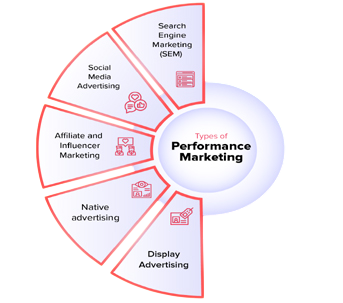Performance Marketing is a digital marketing strategy focused on driving measurable results and outcomes, where advertisers pay based on the performance of their campaigns. Unlike traditional marketing, where businesses pay upfront for ads, performance marketing is outcome-based, meaning advertisers only pay for specific actions such as clicks, conversions, leads, or sales. This model ensures that marketing budgets are allocated efficiently, as the focus is on achieving quantifiable results. Common channels for performance marketing include Search Engine Marketing (SEM), Affiliate Marketing, Social Media Ads, and Display Advertising.
One of its key advantages is the ability to track and analyse data in real-time, allowing businesses to optimise campaigns continuously. Performance marketing helps businesses lower their risk by linking costs directly to the achievement of set goals, making it a highly effective and ROI-driven approach.
Key feature of Performance Marketing
Performance Marketing is a results-driven approach that enables businesses to optimise their marketing efforts by focusing on specific, measurable goals. Advertisers only pay when a predefined action is completed, such as a click, lead, sale, or any other desired outcome. This pay-for-performance model ensures that marketing budgets are spent efficiently, as advertisers are only charged when actual value is delivered. With platforms like Google Ads, Facebook Ads, and affiliate marketing, businesses can track performance in real time, allowing them to tweak campaigns for maximum effectiveness.
One of the key benefits of performance marketing is its transparency and accountability. Advertisers have direct access to performance data, which provides insights into how well campaigns are performing and where improvements can be made.

Cost-Per-Click (CPC) vs. Cost-Per-Acquisition (CPA)
Common Channels for Performance Marketing
Real-Time Tracking and Analytics
ROI Measurement in Performance Marketing
Crisis Management and Brand Recovery
Strategies for Managing Negative Reviews
Lets address your questions today!
What are the main channels used in Performance Marketing?
Common channels in performance marketing include search engine marketing (SEM), social media advertising (such as Facebook Ads and Instagram Ads), affiliate marketing, display advertising, and email marketing. These channels allow businesses to target specific audiences and track the performance of their campaigns.
What is the difference between CPC and CPA in Performance Marketing?
CPC (Cost-Per-Click) refers to paying for each click on an ad, while CPA (Cost-Per-Acquisition) means paying only when a specific action is completed, such as a sale, lead, or download. CPC is focused on driving traffic, while CPA is focused on achieving actual conversions, making CPA more closely tied to performance outcomes.
How is ROI measured in Performance Marketing?
ROI (Return on Investment) in performance marketing is measured by comparing the revenue generated from a campaign to the cost spent on that campaign. A positive ROI means that the revenue generated exceeds the marketing costs, making the campaign profitable. Tools like Google Analytics and platform-specific dashboards help track and calculate ROI in real-time.
What are the benefits of Performance Marketing for businesses?
The main benefits of performance marketing include cost efficiency, as businesses only pay for actual results. It also provides transparency, real-time tracking, and measurable outcomes, allowing marketers to optimize campaigns continuously. Performance marketing ensures better control over budget allocation, higher ROI, and the ability to scale successful campaigns rapidly.

